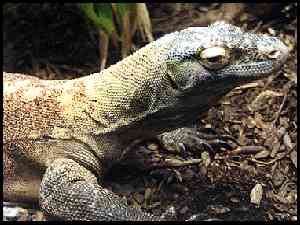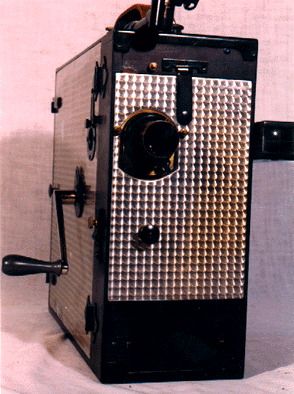
I'm sitting in a Starbucks, and on a standee at the next table is an ad for Komodo Dragon Blend coffee ("Take home the earthy-rich flavors of the Asia Pacific").
Ironic, because I was just getting set to create an entry about an article on
The Unmuseum Website about the explorer W. Douglas Burden:
The party shot several dragons and preserved their bodies for study. The more difficult trick, though, turned out to be bringing some back alive. Traps were built by driving heavy stakes into the ground in a circle, leaving only a large opening on one side. The stakes were then lashed together to form a fence and camouflaged. A nearby tree was stripped of its branches and a rope tied to its top. Fifteen men pulled on the rope to bend the tree over the trap. One part of the rope was fastened to a trigger so that when released the tree would be free to spring back up. The other portion of the rope became a noose that encircled the opening in the stakes. Finally, a nice, ripe, dead boar was placed in the center of the trap as bait.
Normally in a trap like this the bait would be tied to the trigger so that when the animal disturbed the bait, the trap would spring. Burden decided he only wanted to capture the biggest dragons so instead he rigged the trap so he could set it off by pulling a rope from a boma, or blind where he was hiding watching the trap.
Waiting in a small, camouflaged hut in Komodo's jungle was no easy task. The boma was invaded regularly by poisonous foot-long centipedes and stinging scorpions. The men often found themselves thrashing around trying to ward off the creatures.
The account above is somewhat summarized from Douglas Burden's book, "Dragon Lizards of Komodo: An Expedition to the Lost World of the Dutch East Indies" , which I purchased in e-book format (basically a CD containing the scanned book). From the book, here is, ostensibly, a first-hand account:
I told the men that I thought the big one was coming and to hold themselves ready. Then we waited without seeing or hearing a thing for about half an hour. Suddenly one of the coolies made a strange sound. Then he looked around at the other men, and seemed to be unduly excited. On peeping through the back of the boma, I saw that here, in truth, was a dragon—a living remnant of the monster lizards of the Pleistocene.
One black eye was fixed on the boma. I did not dare move. Now he started forward again. He was headed right for the boma. The coolie who had seen what was happening shrunk back. I could see the ugly brute very well. He looked black as ink. His bony armor was scarred and blistered. His eyes, deep set in their sockets, looked out on the world from underneath overhanging brows. Defosse waited placidly without saying a word. Now the creature’s footsteps were plainly audible. He passed right by on one side of the boma. I could have reached out and touched him with my hand, and I had the tingling sensation of actually having a dragon walk by within a yard of where I was standing. The coolies were very restless, and Defosse spent his time keeping them still.
It's fairly well known that Merian C. Cooper was a friend of Burden's and was indeed inspired in part by the Komodo "dragon" stories to pursue a screen story about giant animals.
The old beast, Burden claimed, was over ten feet long and stood in the clearing staring at the boma—and Burden himself—for a full half hour, as if somehow knowing he was being watched and patiently weighing his options.
Finally, he made up his mind and charged the baited trap. Burden triggered his snare and the sapling tree launched upright, enclosing the snare net and yanking the creature upward. Suddenly and unexpectedly, the tree snapped violently under the weight of the beast and it was on the ground, held only by a noose around the waist. Burden’s Malay crew—perfectly sensibly—refused the approach the enraged creature, which was now thrashing his claws and tail about wildly and vomiting. The stench was incredible. Big-game hunter Defosse had had been sharpening his lassoing skills with this sort of eventuality in mind. After three lines were secured, they took the three hundred-pound lizard back to their camp and released it into a sturdy heavy timber and steel mesh cage, planning to take measurements in the morning after it had tired itself out. The lizard continued vomiting, which produced such a horrid, nearly overpowering odor that Burden had the cage moved a quarter-mile from camp. The next day they awoke find wire mesh at the top of the cage torn and the creature gone.
“We felt so sure of him that we hadn’t even taken photographs… There was the hole gaping at us, as evidence of a degree of strength we had never suspected,” wrote Burdon, straining the limits of credulity every bit as hard as the lizard evidently tugged at the cage bars.
It’s a gripping account; perhaps the climax of “Dragon Lizards of Komodo” and certainly the most quoted section (it’s a tale retold, for example, in the book “Dinosaurs in the Attic: An Excursion Into the American Museum of Natural History”). Unfortunately, on the last page of the book, after the careful “Herpetological notes” and a short “Literature cited” section, the following, single afternote appears in smaller type:
NOTE: The snaring of the large lizard which eventually escaped was actually not witnessed by any white man. The account as given in Chapter VII has been drawn from similar scenes that were witnessed.
And
Carl Denham was dismissed as a "showman"?
More ...











